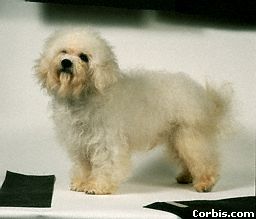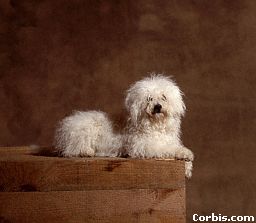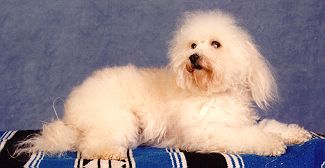|
|
|

 The Bolognese is a member of the Bichon family. Bolognese were developed centuries ago in Bologna, Italy and were valued in Italy as early as the eleventh and twelfth centuries. The breed became a favorite of the nobility during the Renaissance. As time passed and the nobility as such passed, the Bolognese became almost an extinct breed. However a few breeders in Italy and Belgium helped to restore the breed to its present popularity.
Bolognese is a long-coated, white, non shedding dog that is slightly longer than it is tall. It is a sturdy active little dog that is highly intelligent and completely devoted to their masters. It is quick to learn what is expected. They make an excellent obedience and agility dog. They are a friendly dog but will alert their owners of strangers. Bolognese are at their best as a full member of the family. Their purpose down through time has been to be a companion and a lap dog. This a breed that has done well for those that are allergic to dogs.
The Bolognese are registered with the Bolognese Club of America. The breed is also recognized by the United Kennel Club.
The Bolognese is a member of the Bichon family. Bolognese were developed centuries ago in Bologna, Italy and were valued in Italy as early as the eleventh and twelfth centuries. The breed became a favorite of the nobility during the Renaissance. As time passed and the nobility as such passed, the Bolognese became almost an extinct breed. However a few breeders in Italy and Belgium helped to restore the breed to its present popularity.
Bolognese is a long-coated, white, non shedding dog that is slightly longer than it is tall. It is a sturdy active little dog that is highly intelligent and completely devoted to their masters. It is quick to learn what is expected. They make an excellent obedience and agility dog. They are a friendly dog but will alert their owners of strangers. Bolognese are at their best as a full member of the family. Their purpose down through time has been to be a companion and a lap dog. This a breed that has done well for those that are allergic to dogs.
The Bolognese are registered with the Bolognese Club of America. The breed is also recognized by the United Kennel Club.
Height: males 11 - 12 inches, females 10-11 inches at the withers.
Weight: 8 - 14 pounds.
Color: White, not to be faulted for touches of champagne color on the ears or occasionally on the back. Should have an over all look of a white dog.
Coat type: Curly soft double coat.
Maintenance: The coat must be combed regularly.
THE BOLOGNESE HISTORY
 Its origin is often confused with that of the Maltese since its distant ancestors are the same
little dogs mentioned in Latin by Aristotle (384-322 BC) under the name "canis elitensis".
Already known in the Roman era, the Bolognese appeared among the appreciated gifts which were presented during a the era by the powerful of that world.
Cosimo de Medici (1389-1464) brought no less than eight Bolognese to Brussels as gifts to as many Belgium noblemen. Philipe II, King of Spain from 1556 to 1598, after having received two as a gift from the Duke d'Este, thanked the donor by writing "these two little dogs are the most royal gifts one can make to an emperor".
A Bolognese is represented in the painting "le Vieux and Goya" by Pierre Breughel and other paintings by Titian. Many Bolognese of this time period were also white and black and white and gold in color.
Its origin is often confused with that of the Maltese since its distant ancestors are the same
little dogs mentioned in Latin by Aristotle (384-322 BC) under the name "canis elitensis".
Already known in the Roman era, the Bolognese appeared among the appreciated gifts which were presented during a the era by the powerful of that world.
Cosimo de Medici (1389-1464) brought no less than eight Bolognese to Brussels as gifts to as many Belgium noblemen. Philipe II, King of Spain from 1556 to 1598, after having received two as a gift from the Duke d'Este, thanked the donor by writing "these two little dogs are the most royal gifts one can make to an emperor".
A Bolognese is represented in the painting "le Vieux and Goya" by Pierre Breughel and other paintings by Titian. Many Bolognese of this time period were also white and black and white and gold in color.
The Bolognese belongs to the Bichon group originating from those small white dogs called "Melitensis" by Aristotle which became widespread in the Mediterranean countries. It was used on ships to kill vermin and gave origin to the Maltese dog and the other Bichons.
In Italy, as far back as the Roman times, they were considered precious. During the Renaissance the nobility used them as gifts, and in this way they reached the court of Catherine II of Russia. This small "ladies dog" never became popular in the way of numbers, and even today's population has remained rather small.
It has the typical character of other Bichon breeds, as it desires close contact with the human family into which it integrates completely.
The Bolognese is vivacious, extremely intelligent, trainable, and playful, yet discreet and not intrusive.
Kristine K. Steffeck, Kennel Assisi Bolognese, Wausau, Wisconsin, U.S.A.:
 I have been asked many, many times to describe the Bolognese.
I have been asked many, many times to describe the Bolognese.
I believe the following response gives people a little more insight of what living with a Bolognese as part of the family is like.
There is an intelligence and understanding I see in my Bolognese not possessed by any other breed. They know and anticipate before you even say anything, almost telepathically.
They are extremely smart and if you don't think your Bolognese is, then it's much more intelligent than you think. They are true companions and thrive on your attention.
They are agile and light on their feet. They are happy-go-lucky walkers. They are show-offs and know it and love it. They are rough and tumble with each other and children. They make up their own little impish games and delight in outsmarting you. They keep a watchful eye out for intruders. When they exhibit caution toward an individual, take heed, for they sense something you do not.
Their intelligence is obvious by their ability to learn quickly. Their dense long locks of fur form the beautiful white soft coat that you love to bury your face in.
They are devoted and love their whole family. They love getting kisses as much as giving them. They must always know what you are doing and be part of it.
One of their main goals in life is to charm their way into the hearts of everyone they meet, and they usually succeed . . .
. . . This is the Bolognese.